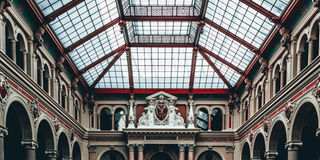Prime
How to incorporate decorative glass in your living spaces

Stained glass turns your skylight into an art piece while also allowing enough light into the space. PHOTO/unsplash.com
What you need to know:
Glass is elegant, versatile and easy to mantain. There are so many glass design options out there to fit the look of any home or space
The elegance of glass adds style and a touch of luxury to every space. Decorative pieces come with distinctive touches such as frosted accents, acid etched, sandblasted, beaded or floral motifs. These items can be used as lamps, mirrors and vases or bowls. Not only will the mirror bring extra light and a sense of openness to the space, but the elegant lighting helps set the right mood.
According to Martin Sserunjogi, a technician at Glass Aspirations, whatever exquisite glass creation you select to grace your home, there is no question that it will serve to showcase your sense of style and help to create a space in which you enjoy spending your time with family members and guests.
Stained glass
Most of us have only seen stained glass in places of worship, especially churches, however, more and more homeowners are opting to use stained glass into their homes. Stained glass brings elegance and colour to a typically boring part of your home’s exterior because of its versatility. There are so many design options out there to fit the look of any home or space. Since stained glass is recommended to be used as an accent piece, it can be best used on the front door or skylight windows.
Frosted glass
Frosted glass or opaque glass is a popular option for homeowners that want to use glass and still maintain some privacy because it blurs the inside and the outside which prevents people outside from looking into your home while still allowing sunlight through.
Glass balustrades
Sserunjogi recommends glass embedded in the stairs of big mansions and colourful glass trails to distinguish the hallways. He says, “This glass option would magnify the staircase and create enough light in this space especially in homes that are closed in and have limited lighting in rooms.”
Frosted or painted glass he adds creates a warm feel for the stair way and functional in adding beauty to the space as well as mindful of occupants usage.
Glass backsplash
The kitchen backsplash usually has a dash of paint hue, stonework, wallpaper or tiles. However, glass acting as backsplash would be a unique pick for one’s kitchen. This is simply because glass is easier to clean off than most surfaces.
“Unlike bathroom wall tiles, property owners can opt for bathroom cabins in glass which are decorative, easy to maintain and also a good partitioning option,” he shares.
A frosted option is most recommended for bathroom spaces as this allows for privacy of users and yet serve a functional goal of adding aesthetics to the space.
The expert says that glass can be incorporated in kitchen and bathroom shelves enhancing a more functional space and leaving items in clear sight of the users.

Glass blocks
Using a glass block wall will make the living room more private for open-plan homes. The living space still feels connected with the rest of the home, looking visually larger due to the unobstructed light flow.
“For doors, an artistic touch to glass either in patterns or features can add a rich feel to the entry way, these patterns are tailored also to meet the users preferences,” he shares.
In the place of decorative glass for windows, homeowners can opt for magnificent glass fitting for the wall spaces especially in the living rooms. This, he says creates spacious feel and light entry into homes hence enhancing more beauty to the space.
Glass etching
Take advantage of etching by using decorative glass to not only increase the size of the room, but also to brand your business. Glass etching is a classic way to promote your brand throughout the entire establishment. Consider adding the logo or name of the business to a glass backsplash or add a glass plate bearing the name of the company anywhere throughout the building.
Glass floors
According to floortechie.com, glass floors are stain-resistant, making them easy to clean. You can simply wipe your glass floor with a wet mop once in a while to remove any built-up dust and debris to keep it looking spectacular. What is more- compared to other types of flooring such as concrete, glass flooring is resistant to fungi and other allergens.
Finally, glass is also resistant to fading due to exposure to sunlight. Installing glass floor is a great way to increase the amount of natural light coming into your rooms, while also enhancing insulation and aesthetics of the property. It is most commonly used on the upper floors to allow for better natural illumination of the rooms on the lower floors.
The strength of glass flooring varies depending on the maximum load it’s expected to take. Glass floors have a robust support structure and are designed to withstand significant foot traffic. Glass that is specifically meant to be used as flooring material is typically five times stronger than regular annealed glass.
For glass to be considered safe to walk on, it needs to boast adequate structural strength. The International Building Code (IBC) provides guidelines on the criteria for determining whether a given type of glass is safe enough to withstand foot traffic.
Generally, heat-strengthened-laminated glass is recommended due to its superior toughness over most types of glass. Avoid installing, standard annealed glass as a flooring structure, as this can expose the house’s occupants to significant safety risks.
Branding
Take advantage of etching by using decorative glass to not only increase the size of the room, but also to brand your business. Glass etching is a classic way to promote your brand throughout the entire establishment. Consider adding the logo or name of the business to a glass backsplash or add a glass plate bearing the name of the company anywhere throughout the building.





